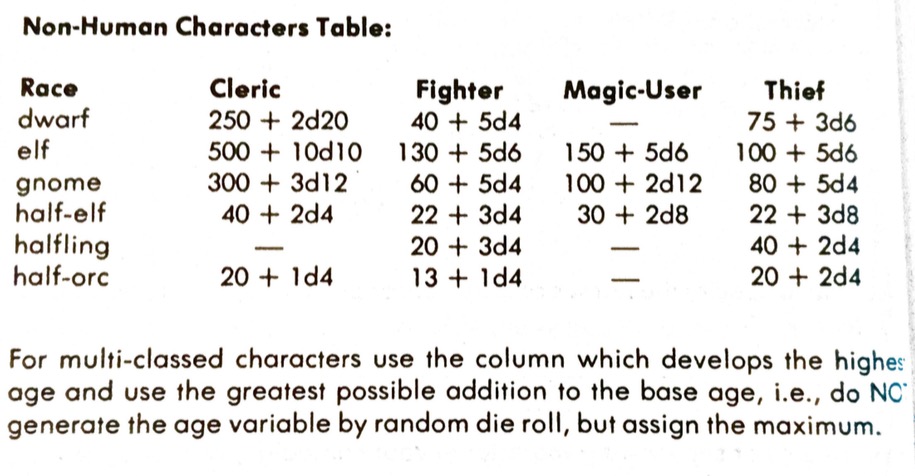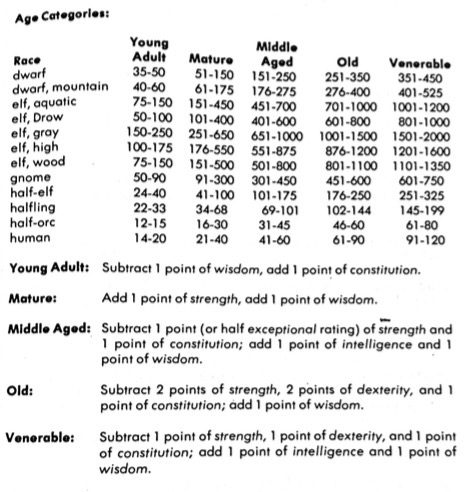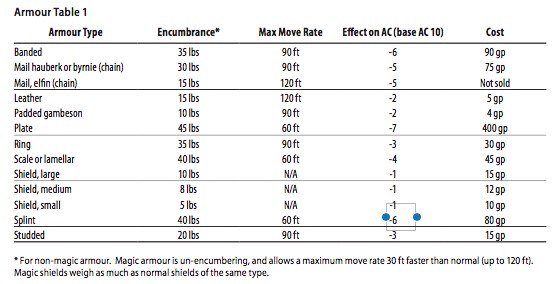Within orthodox Christianity, there’s a concept called “progressive revelation,” which means that God did not reveal everything about Himself at once to humankind. Otherwise, who knows what would’ve happened? Maybe our heads would have exploded, a lá Dogma.
 Regardless, the Christian God chose to reveal Himself in baby steps. And I like to think that Gary Gygax did the same.
Regardless, the Christian God chose to reveal Himself in baby steps. And I like to think that Gary Gygax did the same.
As I have mentioned before, AD&D was released in this order:
Monster Manual (December 1977)
Players Handbook (June 1978)
Dungeon Masters Guide (August 1979)
[These dates come from this unbelievably helpful site]
As a result, the ruleset was somewhat incomplete until all three books were released. Nowhere is this more apparent than in combat and character creation. Since I wrote at length about combat and initiative order last week, let’s focus on character creation this week.
Last week, I rolled up my first three characters: a magic-user, a ranger, and a cleric. I found the Players Handbook to be quite intuitive in the process of creating characters. It was almost as easy to use as the FFG Star Wars RPG books, which I find remarkably user-friendly when it comes to character creation. They’re my gold standard. But occasionally, I found myself scratching my head, flipping through pages, and not finding something that I needed to finish the process.
Well, as it turned out, there is material in the Dungeon Masters Guide for character creation that is not available in the PHB. I don’t think is trying to create overt reliance on the DM for character creation, so much as it’s a bit of progressive revelation. As AD&D developed, Gary realized a need to communicate some other tips to the players. Think of it as errata or clarification, if you will.
Now to help those of you interesting in rolling up a character, here are a few of those additions that will help you out:
Character Sheet
There actually isn’t an official character sheet in any of the AD&D works. That said, this one over at Dragonsfoot is really awesome. For everybody in my weekly group, please print these bad boys off, because we’re going “no digital” on our campaign. That’s right, pencils, lead, erasers, and paper.
Determining of Ability Scores
There are three options giving for doing this on DMG, pg. 11:
- Roll 4d6 and discard the lowest. Add the remaining 3d6 and plug it into an ability score.
- Roll 3d6 twelve times and keep the six highest results as your ability score numbers.
- Roll 3d6 six times for each ability and keep the highest result.
- Roll 3d6 seventy-two times. Each set of six consecutive scores counts for the ability scores (in order) for a different character. Choose the set that seems best and use those for your character.
My group is using the first option for simplicity’s sake.
Determining Character Background
With the lethality of early level play, it’s hard to invest a lot in a backstory. So Gygax provides a table on DMG pg. 12 to determine your PC’s background. The DM is encouraged to give bonuses to players when they do skill checks and the like relating to their background skills. My AD&D group is going to use this table for a little added complexity:
Roll a D100 and on the following results, record this secondary skill for your character (table with explanations borrowed from this site):
01-02 Armorer (make, repair & evaluate armor and weapons)
03-04 Bowyer/Fletcher (make, repair, & evaluate bows and arrows)
05-10 Farmer (basic agriculture)
11-14 Fisher (swimming, nets, and small boat handling)
15-20 Forester (basic wood lore, lumbering)
21-23 Gambler (knowledge of gambling games)
24-27 Groom (animal handling)
28-32 Hunter (basic wood lore, butchering, basic tracking)
33-34 Jeweler (appraisal of gems and jewelry)
35-37 Leather worker (skinning, tanning)
38-39 Limner/Painter (map making, appraisal of art objects)
40-42 Mason (stone-cutting)
43-44 Miner (stone-cutting, assaying)
45-46 Navigator (astronomy, sailing, swimming, navigation)
47-49 Sailor (sailing, swimming)
50-51 Scribe (reading, writing, basic math)
52-53 Shipwright (sailing, carpentry)
54-56 Tailor/Weaver (weaving, sewing, embroidery)
57-59 Teamster/Freighter (animal handling, wagon-repair)
60-62 Trader/Barterer (appraisal of common goods)
63-66 Trapper/Furrier (basic wood lore, skinning)
67-68 Weaponsmith (make, repair, & evaluate weapons)
69-71 Woodworker/Carpenter (carpentry, carving)
72-85 No skill of measurable worth
86-00 Roll twice (reroll any result of 86-00)
Determining Character Age
I feel like this addition to character creation is remarkably cool. Based upon the age of your character, you can get bonuses and deficits to your ability scores. Gygax does add the qualification that “adjustments cannot exceed racial maximums nor can they be used if they cause abilities to exceed stated maximums. Likewise any adjustments cannot lower any ability below racial or class minimums.” So keep that in mind. Here’s how age is determined:
For humans
Cleric/Druid/Thief: 1d4+18
Fighter: 1d4+15
Paladin: 1d4+17
Ranger: 1d4+20
Magic-User: 2d8+24
Illusionist: 1d6+30
Assassin: 1d4+20
Monk: 1d4+21
For non-humans:
 Once age has been determined, make the following adjustments to your ability scores, except when doing so would over- or undershoot limitations based upon class, race, gender, or other:
Once age has been determined, make the following adjustments to your ability scores, except when doing so would over- or undershoot limitations based upon class, race, gender, or other:
I’ve got to thank @mawmingram on Twitter for this tip. When determining encumbrance (PHB, pg. 101), it deals with armor weight in very vague terms. Terms which are more clearly defined in the DMG (pg. 27; reproduced from OSRIC):
Saving throws and “To Hit” Matrices
I’d reproduce these if the tables weren’t so big. For my players (who are reading this blog), I’ll give this stuff to you on our Character Creation night. For all others, check DMG, pp. 74-75, 79.
Once you create a few character, you find yourself flying through this process. The important thing is knowing what you’re looking for and where to find it. So go ahead! Get yourself a PHB and a DMG [affiliate link] and roll up those characters!


